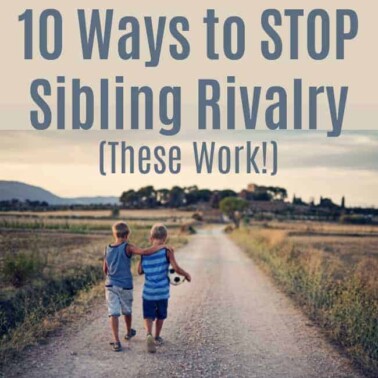This post may contain affiliate links. Please read our disclosure policy.
I try to find rewards that are not toys when I want to show our children that I’m proud of them. Today I’m sharing the reason that we look for non-toy rewards as well as a list of non-toy rewards & non-candy rewards.
Just like science proves that giving our kids an experience is better than a toy, recent studies show that offering toys as rewards may backfire, causing children to be spoiled or grow up to become materialistic adults who are more likely to be in debt.
In complete transparency, I don’t always succeed at giving rewards that aren’t ‘things’. When I find a great toy or when know that our kids have had their eye on something, it’s hard to pass it up, especially when they’ve done something well.
However, I try to remember my ‘longer’ goal of teaching them character traits & behavior.
I want to teach them to be intrinsically motivated and not wait for the next toy or treat. I also don’t want them to expect a toy for each job well done.
A study published in the Journal of Consumer Research found that children who receive more material rewards end up being materialistic.
“Parents don’t want their children to use possessions to define their self-worth or judge others, yet loving and supportive parents can also use material goods to express their love, paving the way for their children to grow up to be more likely than others to admire people with expensive possessions,” said authors Marsha Richins of the University of Missouri and Lan Nguyen Chaplin.
According to TIME.com, “By using possessions to reward—or, on the flip side, punish—children, parents may be setting the stage for long-term overconsumption, the study found. Children raised in households where acts of discipline involved giving or taking away material belongings were found to be more likely to continue rewarding and defining themselves with material things.
If that doesn’t sound bad enough, materialism in adulthood has also been linked to reduced feelings of well-being, marital problems, and financial difficulties…”
So what can you do? Try non-materialistic rewards that your child will look forward to. Here are some ideas that make great alternatives.
List Of Rewards That Are Not Toys
Children need and want time, attention, and communication. These are things that are easily given. Here are some ways to reward children without material goods.
-
Intrinsic Motivation
Encourage your child to be proud of himself/herself. “Wow- aren’t you proud of yourself? You studied hard and looked at what you’ve accomplished. You can do anything with hard work.” In the long run, this kind of intrinsic motivation will make a huge impact.
-
Put It On Display
If it was a great report card- display it on the wall. A great game- post a picture or the score on the refrigerator.
Whenever your child does something unexpectedly nice, helps without being asked, listens with a reminder, or responds in an appropriate way (whatever you are working on), give them a cotton ball to put in their jar.
When the jar is full, encourage your child to “do something fun” by picking out an activity to do together (painting rocks, making non-stick slime, etc.…)
Find out more about this reward system here. It has worked in our family for years.
-
An Outing
Save the rewards for “points” for a fun outing! Set a family goal – a place that you want to go, like a local zoo or trail, then talk about how you will get it (filling up a family cotton ball jar, or getting a certain number of family points, or maybe even something like “if everyone stays in their bed at night unless they really need you.”
-
Pick a Puzzle to Complete
Time together is the key here. Pick one out and work on it together. Yes, you’re buying a puzzle, but your child will see it as a bonding experience because you aren’t “giving” it to them; you are doing it together.
-
Make Something Together
Make a dry erase photo book that you print, like this one. Our kids love to draw funny faces on themselves (or us!) using the book.
-
Use a Sticker Chart to Pick a New Activity.
Every five stickers, they get to do something fun, like baking cookies (let them pick a new recipe for cookies on Pinterest- our kids LOVE to look through pictures of yummy cookies & pick their favorites to make.)
Have the reward be a fun outing with mom or dad. A bike ride goes far in our house – the kids love it, and so do we!
-
“Bucket List” Jar
Make a list of fun activities your child likes, and put them on little pieces of paper. Put those papers into a bucket list jar. When they earn a reward, they can choose an activity.
To make it easier, you can even print a list of fun things to do and put it on the refrigerator. (Examples: make a fort, go on a scavenger hunt, play a board game, etc.)
-
Pajama Day
If your kids love to wear their pajamas, let them have a pajama day at home. You could even have pajama day and movie day.
-
Bonus Screen Time.
If your kids are already swapping chores for screen time, you can offer a “free afternoon.” We do this from time to time.
Example of how it would look in our house: Since our kids aren’t allowed to have electronics during the school week unless it is educational, I might give bonus screen time from 3:00-5:00 on a Wednesday afternoon.
-
Visit An Animal Shelter
Go to your favorite pet store or animal shelter & look at the animals that need to be adopted. You can even ask your children to help you find things to donate to an animal shelter or ask them to donate a dollar to the animal shelter (you do the same), so they are learning about generosity and kindness, too.
-
Move Bedtime Back By 30 Minutes
Let them stay up 30 minutes later to play a game with mom and dad or watch a short show. (Our kids like to find a new show on Netflix that is just “ours” – so when they get a reward, they stay up 30 minutes late to watch the next episode on “our” show. 🙂 )
-
Dinner Time
Celebrate by going out to eat as a family, letting them pick their favorite dinner, or doing something out-of-the-ordinary, like eating dinner on the back porch.
-
Have A Bon Fire
Our family loves to have bonfires in the back yard. We buy everything that we need to make smores (or even nacho smores) and make an evening of it.
-
Find A Local Event
Find a free, fun event in your hometown. Most local libraries offer these for kids several times per week. You can even go to your hometown’s website or Facebook page to find upcoming events for kids. Local churches often have these, too.
Studies Prove it’s Worth It To Stick To Non-Material Rewards
It’s a hard thing to remember, and I’m sure I’ll falter at times. Just try to remember that studies are finding that these children often grow up to be spoiled, materialistic, and often adults living in debt.
According to the Journal of Consumer Research, “Material rewards received in childhood appear to lead people to place emphasis on possessions as a means to develop and transform self-identity, possibly encouraging them to place more importance on goods in general and become more materialistic than their peers who did not receive as many material rewards.”
They go on to say, “Taking a favorite toy from a child who bullies a sibling or removing a game box as a consequence for poor grades are examples of material punishment.”
“Repeated instances of this sort of discipline may lead to an escalation of the importance the child places on possessions, in general, a defining characteristic of materialism.”
















When our children were particularly young we taught them how we are a family, and as such, we work together, play, learn, cry, and do all things together. Our main goal as a family was to live happily together as we learned and grew up to be responsible self reliant citizens and good examples of happiness and kindness. We had a (dry mark erasable) chart wherein if each of us did well, another person could mark the chart with a dot; at the end of the week we would count up the dots and that would equal a certain amount of time spent doing a family activity not otherwise planned (bike trip around the neighborhood, visiting gramma, reading a special book, playing a board game, even serving together by cleaning up a roadway or preparing an activity for a local shelter, that sort of thing). We tried to teach the idea that doing well, achieving a goal, behaving properly, etc. was it’s own reward; as doing well in school or other activities rewards one with more challenging opportunities, so goes life. One doesn’t receive food treats for good behaviour because we are not trained animals, but are offered rewards that will just keep us moving forward. We encouraged our kids from a very early age that service was a fun activity and that doing hard things or working hard, while in the moment might feel difficult, the feeling you receive afterward was incredible! (and yes, sometimes we all need a reminder *during* the service to do it happily, and again afterward to recognize their good pleasant feelings.) Now, as they are all grown adults with their own families, I see the reward in that they are teaching their children the same things -and that is a great feeling!
That’s awesome! Thank you!
I absolutely love these ideas! With everything going on these days and the recent decision to virtual school instead of going to school I need something like this. I like the cottonball idea because they can be used over and over for the reward system.
When I was teaching the self-contained behavioral classroom a reward for one of my students was just simply just going to Dollar Tree to go and look at the toys.